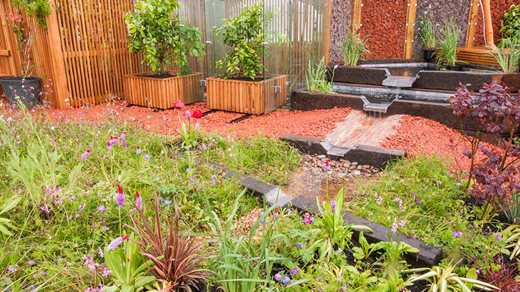
Climate change presents challenges for us all, but getting to the bottom of how we can help protect the environment can be confusing. At the RHS, I am investigating ways in which gardeners throughout the UK can help society adapt to our changing climate.
A show garden like no other
In April 2017, the RHS launched the Gardening in a Changing Climate report, which explores existing scientific evidence with regard to the intrinsic link between gardens and climate change, before recommending ways in which gardeners can adapt to a changing climate. It was clear from the results of the report that people feel unprepared for gardening in a changing climate - they want to take action, but don’t necessarily know how.
This led to the decision to bring to life the recommendations in the report by building a ‘future-proof’ garden at the inaugural RHS Chatsworth Flower Show in Derbyshire. I took the idea to the show manager, who agreed and we asked experts at the University of Sheffield, and included garden management ideas to reflect the climatic challenges that are likely to be faced by gardeners in northern regions of the UK in the latter half of this century. For example around Derbyshire, enough water will likely fall across the year on average, but the water will fall infrequently during intense rainstorms following prolonged periods of dry weather.
To rain or not to rain?
As a result of changing rainfall patterns, the Chatsworth show garden featured creative ideas for water capture and storage, as the average sized water butt is unlikely to hold enough water to last over a dry spell. All the surfaces in the garden were permeable, to allow excess water running off buildings to drain away, avoiding flooding and waterlogging. We also had a rain garden planted with species tolerant of conditions varying between wet and dry, such as Primula vialii which adds incredible colour and structural interest.
If you were able to visit the show or see any of the coverage, you will know that we certainly had some changeable weather that week! In fact, the show had to close on Tuesday due to high winds. Whilst not a great turn of events for the show, it proved to be a great opportunity to demonstrate that the garden actually worked – the water butts recharged nicely, excess water was mopped up by the rain garden and there was no standing water on any of the surfaces for the whole week. The design of the garden was a triumph, and it was great to be able to show the visitors that these ideas actually work!
 From science to society
From science to society
Students from the University of Sheffield worked with me on the garden throughout the week to engage visitors. Needless to say that we all got very wet and became experts on the best places to buy hot drinks!
Despite the weather, we spoke to over 6,500 people and the garden was broadcast on the One Show and BBC Gardeners' World. In all the communications we did, there was an overwhelming sense that visitors were surprised that small changes to their current practices, such as partially sinking a larger water butt, could make such a substantial contribution towards safeguarding our natural resources in years to come.
Take a video tour of the garden for more information, or download the report to see what small changes you could make in your garden to begin adapting to climate change.

